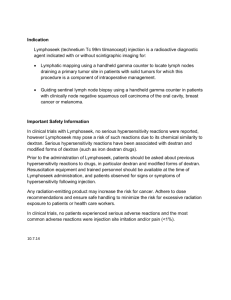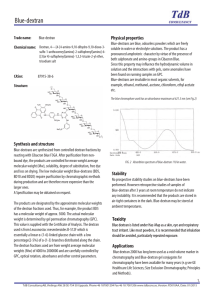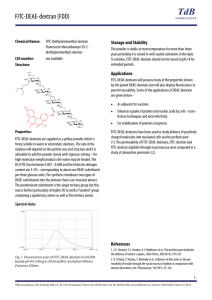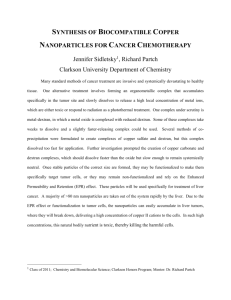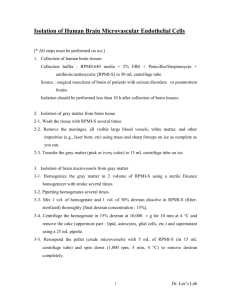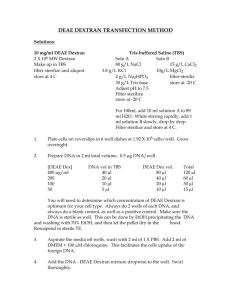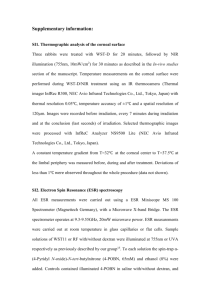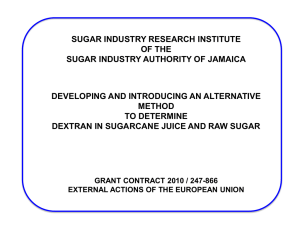An efficient acetylation of dextran
advertisement
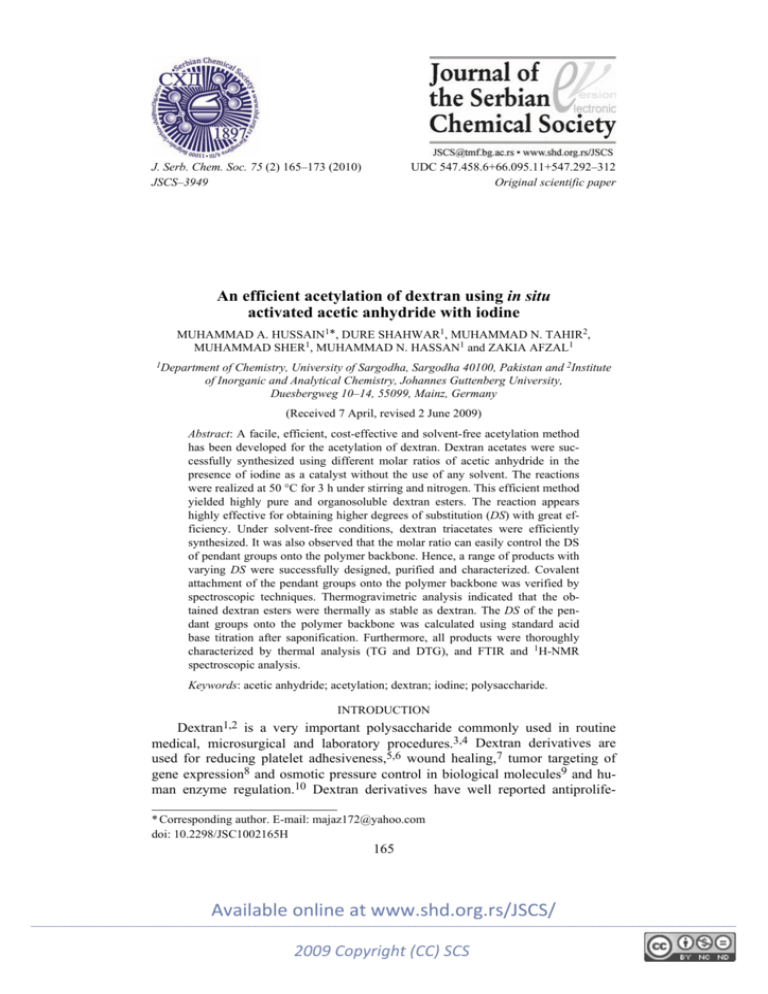
J. Serb. Chem. Soc. 75 (2) 165–173 (2010) JSCS–3949 UDC 547.458.6+66.095.11+547.292–312 Original scientific paper An efficient acetylation of dextran using in situ activated acetic anhydride with iodine MUHAMMAD A. HUSSAIN1*, DURE SHAHWAR1, MUHAMMAD N. TAHIR2, MUHAMMAD SHER1, MUHAMMAD N. HASSAN1 and ZAKIA AFZAL1 1Department of Chemistry, University of Sargodha, Sargodha 40100, Pakistan and 2Institute of Inorganic and Analytical Chemistry, Johannes Guttenberg University, Duesbergweg 10–14, 55099, Mainz, Germany (Received 7 April, revised 2 June 2009) Abstract: A facile, efficient, cost-effective and solvent-free acetylation method has been developed for the acetylation of dextran. Dextran acetates were successfully synthesized using different molar ratios of acetic anhydride in the presence of iodine as a catalyst without the use of any solvent. The reactions were realized at 50 °C for 3 h under stirring and nitrogen. This efficient method yielded highly pure and organosoluble dextran esters. The reaction appears highly effective for obtaining higher degrees of substitution (DS) with great efficiency. Under solvent-free conditions, dextran triacetates were efficiently synthesized. It was also observed that the molar ratio can easily control the DS of pendant groups onto the polymer backbone. Hence, a range of products with varying DS were successfully designed, purified and characterized. Covalent attachment of the pendant groups onto the polymer backbone was verified by spectroscopic techniques. Thermogravimetric analysis indicated that the obtained dextran esters were thermally as stable as dextran. The DS of the pendant groups onto the polymer backbone was calculated using standard acid base titration after saponification. Furthermore, all products were thoroughly characterized by thermal analysis (TG and DTG), and FTIR and 1H-NMR spectroscopic analysis. Keywords: acetic anhydride; acetylation; dextran; iodine; polysaccharide. INTRODUCTION Dextran1,2 is a very important polysaccharide commonly used in routine medical, microsurgical and laboratory procedures.3,4 Dextran derivatives are used for reducing platelet adhesiveness,5,6 wound healing,7 tumor targeting of gene expression8 and osmotic pressure control in biological molecules9 and human enzyme regulation.10 Dextran derivatives have well reported antiprolife* Corresponding author. E-mail: majaz172@yahoo.com doi: 10.2298/JSC1002165H 165 Available online at www.shd.org.rs/JSCS/ ___________________________________________________________________________________________________________________________ 2009 Copyright (CC) SCS 166 HUSSAIN et al. rative and anti-tumor properties.11 Dextran is receiving attention in the formulation of macromolecular prodrugs of acid sensitive drugs to target them to the colon and in this way, highly sensitive anticancer drugs, such as mitomycin C, can be safely targeted to its site of action.12 Nowadays, dextran is being used for sustained release studies of several sensitive drug molecules after their covalent attachment (mostly esters) onto polymer backbone.13 From these research areas, it is clear that esterification of dextran is a very important reaction in drug design. Hence, it is of high importance to develop highly efficient and soft esterification methods. Regarding the esterification of polysaccharides, a few methods are reported in the literature, such as using acetyl chloride with pyridine,14 acetic anhydride with pyridine and 4-(dimethylamino)pyridine,15,16 carboxylic acids in situ activated with tosyl chloride,17–19 iminium chloride20 and 1,1’-carbonyldiimidazole17,21,22 and acetic anhydride activated with strong acids or metal catalysts. In present study, our interests were focused on the search for efficient reaction methodologies for the esterification of the biologically important polysaccharide dextran. Hence, the value of the conventional reagent acetic anhydride was explored using iodine as the catalyst.23 This esterification method appeared more advantageous regarding cost effectiveness because the other esterification methods available until now need expensive acylation reagents, i.e., p-toluenesulfonyl chloride,19 1,1’-carbonyldiimidazole,20 etc. Secondly, the esterification of polysaccharides under homogeneous reaction conditions is a current area of research. However, the fact that solvent systems used to dissolve polysaccharides are quite expensive cannot be neglected; therefore, such methods cannot be readily commercialized. Another important aspect of commercial synthesis of polysaccharide acetates is that an acidic catalyst is employed, which significantly destroys glycosidic linkages of polysaccharides. Hence, the aim of this study was to exploit the use of a mild catalyst, i.e., iodine. Being a cheap, commercially available, environment friendly and most importantly powerful reagent, iodine is currently being extensively explored regarding its catalytic properties on various substrates in different low molecular weight organic transformations.24,25 Likewise, the focus of this investigation was to examine the possibility of employing the acid anhydride/iodine system for the acetylation of dextran. EXPERIMENTAL Reagents and chemicals Dextran (Mw 40000, Fluka) was dried under vacuum at 110 °C for 8 h prior to use. Analytical grade organic solvents and other reagents obtained from Fluka were used without further purification. Measurements The FTIR spectra were recorded on an IRPrestige-21 instrument (Shimadzu, Japan) using the KBr pellet technique. The 1H-NMR spectra of the products were acquired on a Available online at www.shd.org.rs/JSCS/ ___________________________________________________________________________________________________________________________ 2009 Copyright (CC) SCS AN EFFICIENT ACETYLATION OF DEXTRAN 167 Bruker 400 MHz instrument in suitable deuterated solvents. Thermogravimetric (TG) analysis and derivative thermogravimetric (DTG) analysis were realized on a SDT Q600 (USA) thermal analyzer. Thermal decomposition temperatures (td) of the dextran esters were determined from the DTG curves. The td is reported as the onset of significant weight loss from a heated sample. Samples (10 mg) were measured under air at heating rate of 10 °C/min from 35 up to 600 °C. Esterification of dextran using acetic anhydride and iodine under solvent-free conditions, a typical example (sample 4) Iodine (0.50 g, 0.0041 mol) was filled into a pre-dried round bottom flask. Acetic anhydride (4.0 mL, 0.038 mol) was added and the reaction mixture was kept under stirring for 15 min. Pre-dried dextran (1.0 g, 0.0062 mol) was added and the resulting mixture was refluxed for 4 h. The excess of iodine (catalyst) was removed by adding a saturated aqueous sodium thiosulfate solution to the reaction mixture. The thus formed white precipitates of dextran acetate were filtered off, washed thrice with cold water and then reprecipitated from acetone into cold water. The precipitate of sample 4 was then dried under vacuum at 50 °C for 24 h. Yield: 77 %; DS (degree of substitution): 2.90 (the DS was calculated by acid base titration after saponification). FTIR (KBr, cm-1): 2931 (C–H stretching of sugar units), 1751 (C=O stretching ester), 1246 (C–O–C stretching of ester), 1431 (CH2 stretching of sugar units). 1H-NMR (400 MHz, acetone-d6, δ / ppm): 3.15–4.93 (anhydroglucose unit–H), 2.02 (acetyl–H). Calculation of degree of substitution, a typical procedure For the purpose of DS calculation, 100 mg of sample was dissolved in 50 mL aqueous 1.0 M NaOH solution , stirred overnight and its pH was registered using a pH meter. HCl (0.010 M) was added to achieve pH 7, followed by a known quantity (20 mL) of 1.0 M NaOH solution. The excess base was finally titrated with 0.10 M HCl until neutralization. The DS of the free acid moieties was then calculated. The DS of acetyl moiety was calculated by 1 15 H-NMR spectrum from spectral integral ratios of the protons of the AGU and methyl of the acetyl moiety. RESULTS AND DISCUSSION An acid anhydride and an alcohol react together in the presence of iodine as a catalyst. The general mechanism is outlined in Fig. 1 using acetic anhydride as the example.24,25 Iodine first activates acetic anhydride in the presence of alcoholic groups, as the oxygen of R–OH attacks the carbonyl carbon resulting in sp3 hybridization. The acetic ester of the respective alcohol is formed by reaction of the iodide ion with the iodine atom that was attached to the oxygen of the carbonyl group, resulting in free iodine. Acetic acid is formed as a by-product. At the end of the reaction, addition of a saturated aqueous solution of sodium thiosulfate removes all the free iodine. Bearing in mind the immense importance and proved efficiency of iodine as a catalyst for acetylation of alcohols under solvent-free conditions, the aim was to explore its potential for employment in the acetylation of polysaccharides such as dextran. Dextran was reacted with acetic anhydride under solvent-free conditions using different mole ratios of acetic anhydride (see Fig. 1). All the reactions Available online at www.shd.org.rs/JSCS/ ___________________________________________________________________________________________________________________________ 2009 Copyright (CC) SCS 168 HUSSAIN et al. were performed at 50 °C for 3 h under a nitrogen atmosphere. The reaction conditions and the results of dextran acetylation are summarized in Table I. (a) (b) Fig. 1. a) Dextran acetylation with acetic anhydride catalyzed by iodine under solvent-free conditions and b) the generalized mechanism for alcohol (dextran) acetylation. TABLE I. Conditions and results of acetylation of dextran with acetic anhydride in situ activated with iodine under solvent-free conditions Sample 1 2 3 4 5 6 a a Mole ratio 1:3 1:4 1:5 1:6 1:8 1:10 Yield, % 50 53 70 77 83 85 b DS 1.75 1.88 2.69 2.90 3.00 3.00 b c DS 1.72 1.83 2.71 2.85 2.98 2.99 c Anhydroglucose unit (AGU):acetic anhydride; DS calculated by acid-base titration after saponification; DS 1 calculated by H-NMR spectroscopy All the obtained dextran acetates (1–6) were of high purity and soluble in organic media, e.g., dimethyl sulfoxide (DMSO), N,N-dimethylacetamide (DMA) and dimethylformamide (DMF). Samples 4–6 were additionally soluble in chloroform. All samples were insoluble in aqueous media. The dextran acetates were Available online at www.shd.org.rs/JSCS/ ___________________________________________________________________________________________________________________________ 2009 Copyright (CC) SCS AN EFFICIENT ACETYLATION OF DEXTRAN 169 purified by re-precipitation and their purity was verified by spectroscopic techniques. It was found that on increasing the molar ratio of acetic anhydride to dextran, the degree of substitution (DS) also increased, which means that in this way, the DS can be controlled. This observation is obvious from the results given in Table I. The products were obtained with excellent yields. The results significantly indicated that this method is highly efficient for the synthesis of dextran acetates as samples 4–6 were obtained with almost complete substitution under solvent free-conditions. As dextran is a 1–6-linked polymer, a primary hydroxyl, which is generally more reactive toward acetylation, is absent in dextran. In addition, even dextran triacetate was achieved by using less than 1:8 anhydroglucose unit, AGU:acetic anhydride. Therefore, this method has the potential to be exploited for acetylation of polysaccharides in industry. All dextran acetates were thoroughly characterized by means of thermal analyses, and FTIR and 1H-NMR spectroscopy. FTIR spectroscopic studies were performed using the KBr pellet technique to observe the ester peaks and hydroxyl group absorptions. A distinct ester peak appeared at 1747 cm–1 for sample 5 (Fig. 2). The spectrum did not display hydroxyl group absorption at about 3500 cm–1, which is indicative of complete substitution of the hydroxyl functions with acetate moieties. This shows the purity of the product and the success of the reaction. No peak was observed for any kind of possible impurity. For reference, the spectrum of the unsubstituted dextran polymer is being also provided in Fig. 2. Fig. 2. FTIR (KBr) spectra of unsubstituted dextran polymer (▪▪▪) and dextran acetate 5 (―). Available online at www.shd.org.rs/JSCS/ ___________________________________________________________________________________________________________________________ 2009 Copyright (CC) SCS 170 HUSSAIN et al. From DTG analysis, a thermal decomposition temperature (td) of 385.5 °C was obtained for dextran acetate 5. Typical TG and DTG curves of sample 5 are shown in Fig. 3. Dextran acetate 5 showed increased stability when compared to the unsubstituted dextran polymer (td = 315.35 °C, Fig. 4). Fig. 3. Simultaneous DTG and TG curves of dextran acetate 5. Fig. 4. Simultaneous DTG and TGA curves of unsubstituted dextran polymer. Available online at www.shd.org.rs/JSCS/ ___________________________________________________________________________________________________________________________ 2009 Copyright (CC) SCS AN EFFICIENT ACETYLATION OF DEXTRAN 171 1H-NMR spectroscopy was thoroughly performed to check the success of the reaction and purity of the samples. A typical 1H-NMR spectrum of dextran acetate 1 recorded in CDCl3 is shown in Fig. 5. The spectrum revealed the success of the reaction as methyl protons of the acetyl moiety appeared at 2.05 ppm. The signals of AGU-H appeared well resolved at about 3.15–4.90 ppm. 1H-NMR spectroscopy was also performed to calculate the DS of pendant acetyl groups onto dextran. The DS was successfully calculated from the ratios of the integrated peak areas. The results of the DS calculated from the 1H-NMR results were found to be comparable with the DS values obtained by acid base titration after saponification (see Table I). 1 Fig. 5. 400 MHz H-NMR spectrum (CDCl3) of dextran acetate 1. CONCLUSIONS In the present research work, a new method for the esterification of dextran was successfully designed, in which dextran was allowed to react with acetic anhydride in situ activated by the versatile reagent iodine. Highly pure and organosoluble dextran acetates were successfully synthesized, purified and characterized. This easily applicable method appeared highly efficient for the acetylation of dextran. As all reactions were performed at 50 °C for only 3 h, the reaction was highly efficient, fast, time saving and energy effective. Dextran acetylation up to complete substitution of free hydroxyl by acetyl moieties was successfully achieved under solvent-free conditions. As iodine is a cheap, commercially available and environment-friendly reagent, this reaction methodology could be adopted on a commercial scale for the acetylation of polysaccharides. Available online at www.shd.org.rs/JSCS/ ___________________________________________________________________________________________________________________________ 2009 Copyright (CC) SCS 172 HUSSAIN et al. Acknowledgement. Financial support of the Higher Education Commission of Pakistan under the scheme entitled “International linkages of Pakistani Universities with Foreign Universities” is greatly acknowledged. ИЗВОД ЕФИКАСАНО АЦЕТИЛОВАЊE ДЕКСТРАНА У МАСИ АКТИВИРАЊЕМ АНХИДРИДА СИРЋЕТНЕ КИСЕЛИНЕ ЈОДОМ 1 1 2 1 MUHAMMAD A. HUSSAIN , DURE SHAHWAR , MUHAMMAD N. TAHIR , MUHAMMAD SHER , 1 1 MUHAMMAD N. HASSAN и ZAKIA AFZAL 1 2 Department of Chemistry, University of Sargodha, Sargodha 40100, Pakistan и Institute of Inorganic and Analytical Chemistry, Johannes Guttenberg University, Duesbergweg 10–14, 55099, Mainz, Germany У раду је приказан једноставан, ефикасан и јефтин поступак ацетиловања декстрана у маси тј. без присуства растварача. Ацетати декстрана су успешно синтетисани коришћењем различитих молских односа анхидрида сирћетне киселине и анхидроглукозне јединице из полимерног ланца и у присуству јода као катализатора. Реакције ацетиловања декстрана су извођене на температури 50 °C током 3 h уз мешање у инертној атмосфери азота. Добијени естри декстрана су били високе чистоће и растворни у органским растварачима. Реакција ацетиловања је врло ефикасна и добијени су производи високог степена супституције као и триацетати декстрана. Такође је уочено да се помоћу молског односа анхидрида сирећетне киселине и анхидроглукозне јединице декстрана може лако контролисати степен суптитуције (DS) хидроксилних група у полимерном ланцу. Дакле, серија узорака декстрана различитог степена супституције је дизајнирана, синтетисана, пречишћена и окарактерисана. Ковалентни карактер веза супституисаних група и молекула декстрана је потврђен спектроскопским техникама. Термогравиметрија је показала да су синтетисани естри декстрана сличне термичке стабилности као и полазни полимер, односно декстран. Степен супституције хидроксилних група на полимерном ланцу је одређиван користећи стандардни поступак титрације киселином након сапонификације. Сви узорци ацетилованог декстрана су у пот1 пуности окарактерисани термичком анализом (TGA и DTG), FTIR и H-NMR спектроскопијом. (Примљено 7. априла, ревидирано 2. јуна 2009) REFERENCES 1. 2. 3. 4. 5. 6. 7. 8. 9. 10. E. Khalikova, P. Susi, T. Korpela, Microb. Mol. Biol. Rev. 69 (2005) 306 S. S. Dhaneshwar, M. Kandpal, N. Gairola, S. S. Kadam, Indian J. Pharm. Sci. 68 (2006) 705 E. Rotureau, M. Leonard, E. Dellacherie, A. Durand, J. Colloid Interface Sci. 279 (2004) 68 D. Carvalho, H. Dorigo, D. Bouskela, Shock 15 (2001) 157 N. Siddika, E. Mbemba, D. Letourneur, L. Ylisastigui, A. Benjouad, L. Saffar, J. C. Gluckman, J. Jozefonvicz, L. Gattegno. Biochim. Biophys. Acta 1362 (1997) 47 R. Huynh, F. Chaubet, J. Jozefonvicz, Carbohydr. Res. 332 (2001) 75 D. L. Avramoglou, R. Huynh, F. Chaubet, L. Sedel, A. Meunier, Biochem. Pharmacol. 63 (2002) 129 H. Hosseinkhani, T. Aoyama, O. Ogawa, Y. Tabata, J. Controlled Release 88 (2003) 297 E. Rotureau, M. Leonard, E. Marie, D. Dellacherie, T. A. Camesano, A. Durand, Colloids Surf., A. 288 (2006) 131 D. Ledoux, D. L. Merciris, D. Barritault, J. P. Caruelle, FEBS Lett. 537 (2003) 23 Available online at www.shd.org.rs/JSCS/ ___________________________________________________________________________________________________________________________ 2009 Copyright (CC) SCS AN EFFICIENT ACETYLATION OF DEXTRAN 173 11. P. Bittoun, T. Avramoglou, J. Vassy, M. Crepin, F. Chaubet, S. Fermandjian, Carbohydr. Res 322 (1999) 247 12. R. Y. Cheung, Y. Ying, M. Andrew, A. M. Rauth, N. Marcon, X. Y. Wu, Biomaterials 26 (2005) 5375 13. Y. Miyazaki, K. Ogihara, S. Yakou, T. Nagai, K. Takayama, Int. J. Pharm. 258 (2003) 21 14. N. Teramoto, M. Shibata, Carbohydr. Polym. 63 (2006) 476 15. T. F. Liebert, M. A. Hussain, T. Heinze, Macromol. Symp. 223 (2005) 79 16. Y. Tezuka, Carbohydr. Res. 305 (1998) 155 17. M. A. Hussain, J. Polym. Sci., Part A: Polym. Chem. 46 (2008) 747 18. T. F. Liebert, M. A. Hussain, M. N. Tahir, T. Heinze, Polym. Bull. 57 (2006) 857 19. T. Heinze, T. F. Liebert, K. S. Pfeiffer, M. A. Hussain, Cellulose 10 (2003) 283 20. M. A. Hussain, T. F. Liebert, T. Heinze, Macromol. Rapid Commun. 25 (2004) 916 21. M. A. Hussain, T. F. Liebert, T. Heinze, Polym. News 29 (2004) 14 22. M. A. Hussain, T. Heinze, Polym. Bull. 60 (2008) 775 23. A. Memmi, R. Granet, Y. Champavier, P. Krausz, E-Polym. 83 (2005) 401 24. M. Adinolfi, G. Barone, A. Iadonisi, M. Schiattarella, Tetrahedron Lett. 44 (2003) 4661 25. P. Phukan, Tetrahedron Lett. 45 (2003) 4785. Available online at www.shd.org.rs/JSCS/ ___________________________________________________________________________________________________________________________ 2009 Copyright (CC) SCS
